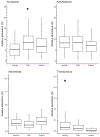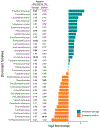The unexpected habitat in sewer pipes for the propagation of microbial communities and their imprint on urban waters
- PMID: 30682717
- PMCID: PMC7018504
- DOI: 10.1016/j.copbio.2018.12.010
The unexpected habitat in sewer pipes for the propagation of microbial communities and their imprint on urban waters
Abstract
Modern urban sewer pipe infrastructure is a unique niche where microbes can thrive. Arcobacter, Acinetobacter, Aeromonas, and Trichococcus are among the organisms that dominate the microbial community of sewage influent, but are not major members of human fecal microbiome, drinking water, or groundwater. Pipe resident communities in untreated sewage are distinct from sewer biofilm communities. Because of their high biomass, these organisms likely have a role in biotransformation of waste during conveyance and could represent an important inoculum for treatment plants. Studies demonstrate stormwater systems act as direct conduits for sewage to surface waters, releasing organisms propagated in sewer pipes. Frequent occurrence of these pipe residents, in particular Arcobacter, demonstrates the extent that urban infrastructure impacts rivers, lakes, and urban coasts worldwide.
Copyright © 2019 The Authors. Published by Elsevier Ltd.. All rights reserved.
Figures




Similar articles
-
Guts of the Urban Ecosystem: Microbial Ecology of Sewer Infrastructure.mSystems. 2022 Aug 30;7(4):e0011822. doi: 10.1128/msystems.00118-22. Epub 2022 Jun 28. mSystems. 2022. PMID: 35762794 Free PMC article.
-
The microbiome of urban waters.Int Microbiol. 2015 Sep;18(3):141-9. doi: 10.2436/20.1501.01.244. Int Microbiol. 2015. PMID: 27036741 Free PMC article. Review.
-
A microbial signature approach to identify fecal pollution in the waters off an urbanized coast of Lake Michigan.Microb Ecol. 2013 May;65(4):1011-23. doi: 10.1007/s00248-013-0200-9. Epub 2013 Mar 9. Microb Ecol. 2013. PMID: 23475306 Free PMC article.
-
Urban microbial ecology of a freshwater estuary of Lake Michigan.Elementa (Wash D C). 2015;3:000064. doi: 10.12952/journal.elementa.000064. Epub 2015 Jul 29. Elementa (Wash D C). 2015. PMID: 26866046 Free PMC article.
-
Urban wet-weather flows: sources of fecal contamination impacting on recreational waters and threatening drinking-water sources.J Toxicol Environ Health A. 2004 Oct 22-Nov 26;67(20-22):1765-77. doi: 10.1080/15287390490492430. J Toxicol Environ Health A. 2004. PMID: 15371215 Review.
Cited by
-
Amplicon-guided isolation and cultivation of previously uncultured microbial species from activated sludge.Appl Environ Microbiol. 2023 Dec 21;89(12):e0115123. doi: 10.1128/aem.01151-23. Epub 2023 Dec 5. Appl Environ Microbiol. 2023. PMID: 38051071 Free PMC article.
-
Development of an in vitro biofilm model for the study of the impact of fluoroquinolones on sewer biofilm microbiota.Front Microbiol. 2024 Mar 27;15:1377047. doi: 10.3389/fmicb.2024.1377047. eCollection 2024. Front Microbiol. 2024. PMID: 38601931 Free PMC article.
-
A Metagenomic Investigation of Spatial and Temporal Changes in Sewage Microbiomes across a University Campus.mSystems. 2022 Oct 26;7(5):e0065122. doi: 10.1128/msystems.00651-22. Epub 2022 Sep 19. mSystems. 2022. PMID: 36121163 Free PMC article.
-
Cellular RNA levels define heterotrophic substrate-uptake rate sub-guilds in activated sludge microbial communities.Interface Focus. 2023 Jun 9;13(4):20220080. doi: 10.1098/rsfs.2022.0080. eCollection 2023 Aug 6. Interface Focus. 2023. PMID: 37303744 Free PMC article.
-
Toward an intensive understanding of sewer sediment prokaryotic community assembly and function.Front Microbiol. 2023 Dec 20;14:1327523. doi: 10.3389/fmicb.2023.1327523. eCollection 2023. Front Microbiol. 2023. PMID: 38173681 Free PMC article.
References
-
- Liu Y, Dong Q, Shi H: Distribution and population structure characteristics of microorganisms in urban sewage system. Appl Microbiol Biotechnol 2015, 99:7723–7734. - PubMed
-
- Tang J, Bu Y, Zhang XX, Huang K, He X, Ye L, Shan Z, Ren H: Metagenomic analysis of bacterial community composition and antibiotic resistance genes in a wastewater treatment plant and its receiving surface water. Ecotoxicol Environ Saf 2016, 132:260–269. - PubMed
Publication types
MeSH terms
Substances
Grants and funding
LinkOut - more resources
Full Text Sources

